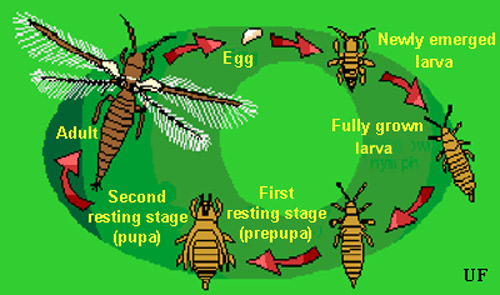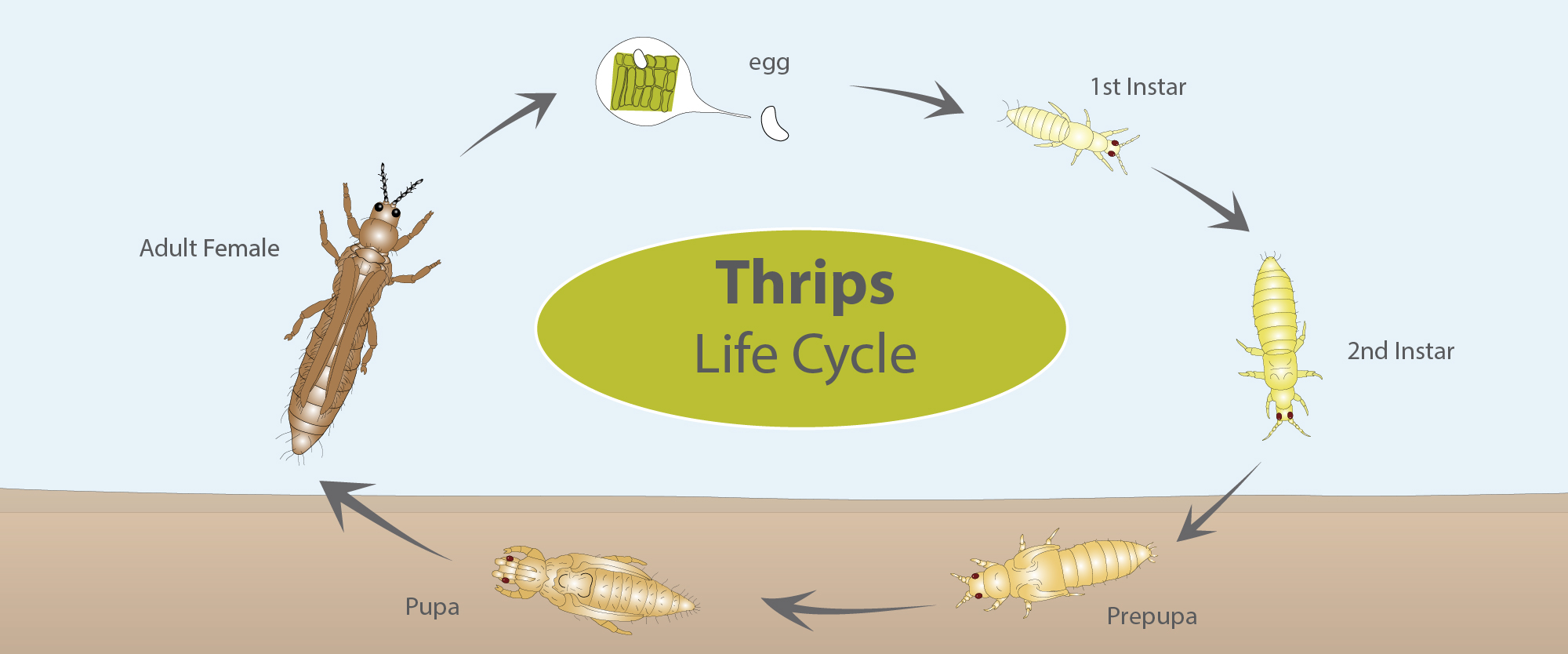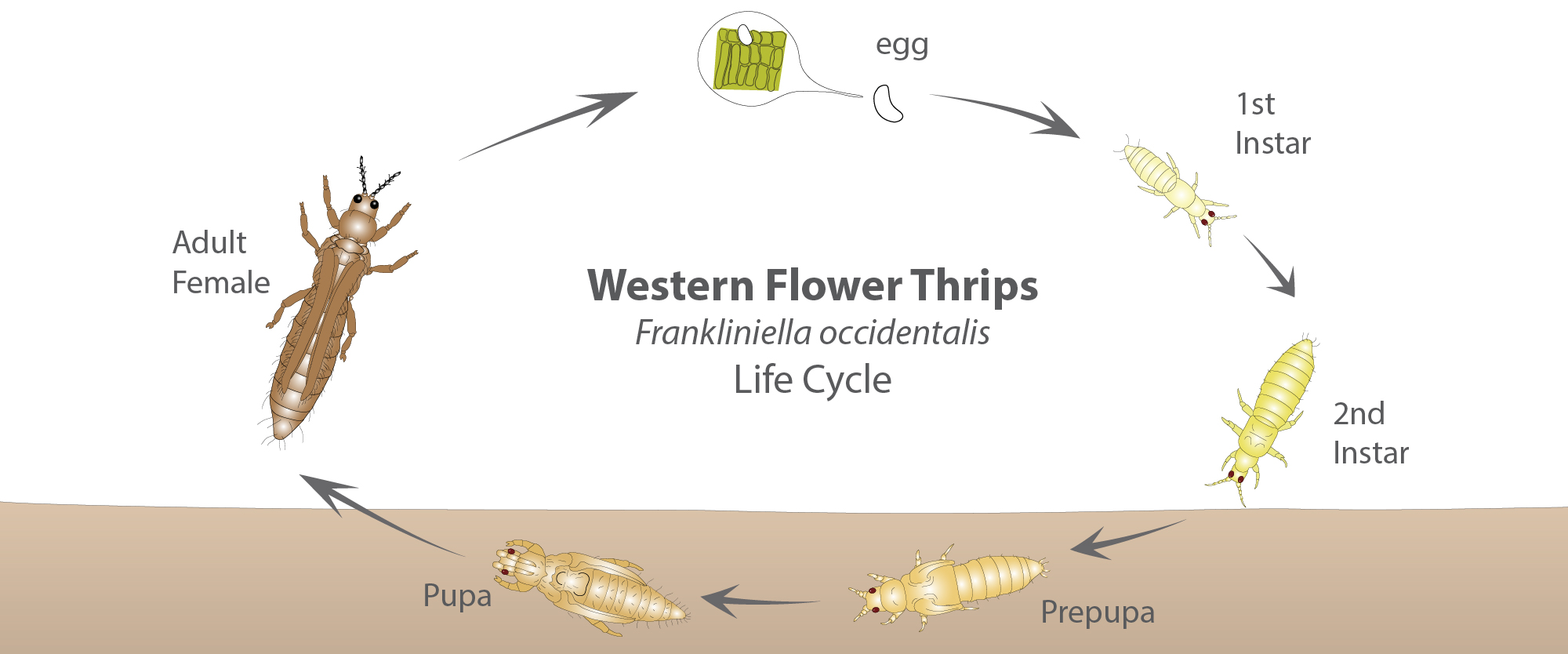citrus thrips life cycle
First-instar nymph second-instar nymph prepupa pupa adult eggs Figure 9. Thrips are not too picky about the plants they will feed from during their lifetime.
It can complete a life cycle in 14 - 20 days and is capable of reproducing both sexually and asexually parthenogenesis.

. Plants Favored by Thrips. Because thrips are tiny identification using a hand lens may be very difficult. Onion thrips Thrips tabaci Lindeman.
When food is suboptimal and the weather is colder the life cycle can be 45 days. Burrow Flower Thrips Frankliniella bispinosa Morgan and Frankliniella kelliae Sakimura ENY-2063 Life Cycle Thrips eggs are small and embedded into flower parts making them hard to detect and often not identifiable. Generations per year up to 40.
The time taken to complete their life cycle ranges from as little as two weeks in mid-summer to 25 3 months in winter. Thrips are able to reproduce sexually asexually or bisexually. Type of reproduction sexual male female oviparity egg-laying In exceptional cases asexual parthenogenesis and live birth.
Were plague thrips Thrips imaginis which will not damage fruit. Active during daytime. Eggs are laid in soft leaf tissues or young fruit and can take 6-24 days to hatch depending on temperature.
Eggs are laid in soft leaf tissues or young fruit and can take 6-24 days to hatch depending on temperature. Approximately 125 GDDF after this biofix date adult thrips will emerge and this is the optimum time for insecticide treatment. During spring and summer females lay about 25 eggs in new leaf tissue young fruit or green twigs.
At the end of their nymph stages thrips populations cease feeding and fall to pupate in plant debris or within plant crevices or galls. Citrus thrips life cycle Citrus thrips go through an incomplete metamorphosis called hemimetabolism. Trips de los cítricos.
An Introduction to Thrips Variations in the length of each life stage occur between thrips species but in general. Scirtothrips clivicola Hood 1957. Thrips may also leave excrement on plants.
Immature thrips are similar to adults but are wingless. Adult citrus thrips are small orange-yellow insects with fringed wings. Citrus thrips Scirtothrips citri Moulton.
Overwintered eggs hatch in March about the time of the new spring growth. The thrip life cycle takes approximately 2 weeks completes and consists of an egg stage a feeding larval stage non-feeding prepupal and pupal stages and finally an adult stage. Mite numbers increase in spring late summer and early fall in response to new growth.
Thrips can be monitored using yellow sticky paper and controlled with the help of natural predators proper weed management plant covers and reflective mulch. Then the prepupal and pupal stages take an additional 4 days and generally occur in the soil. Two larval stages require about 6 days for completion.
The life cycle from egg to egg may be as short as 12 days during warm weather. Thrips have an unusual life cycle that starts with hatching from an egg and then going through two feeding larval stages followed by two non-feeding stages called the pre-pupa and pupa. When food availability is optimal the life cycle lasts 20 days during October and November.
Key thrips lifecycle facts. In the thrips life cycle egg-to-adult development takes about 16 days. Eggs are long and cylindrical and are laid on leaves buds or other locations where emerging larvae may be able to feed.
The thrips life cycle begins in the egg stage before the thrips hatch and begin development. Eggs inserted into the plant tissue by the females sharp egg-laying tube ovipositor hatch in about 6 days. When food availability is optimal the life cycle lasts 20 days during October and November.
A few types have more larval stages some reaching as many as five. Thrips are haplodiploid with haploid males from unfertilised eggs as in Hymenoptera and diploid females capable of parthenogenesis reproducing without fertilisation many species using. Females may lay 80-30 eggs depending upon species host and temperature.
Egg nymph and adult. Development stages of thrips include eggs two nymph stages pre-pupa pupa and adults. Greenhouse thrips pupate on the undersides of leaves whereas Laurel thrips pupate within the leaf tissue.
THRIPS LIFE CYCLE. Two larval stages require about 6 days for completion. Thrips can survive the winter as adults or through egg or pupal diapause.
Larvae are white to yellow. Larvae emerge and begin to feed on the plant. In fall overwintering eggs are laid mostly in the last growth flush of the season.
Appearance and life cycle of Citrus thrips. In the thrips life cycle egg-to-adult development takes about 16 days. LIFE CYCLE Thrips hatch from an egg and develop through two actively feeding larval stages and two nonfeeding stages the prepupa and pupa before becoming an adult.
Thrips lifespan 45 days as an adult not including hibernation. Euthrips citri Moulton 1909. Citrus Pest Quick Guide.
Each female lays 20 to 50 eggs at a rate of 2 to 3 a day depositing them on both sides of leaves. In fact they are known to target more than 500 plants. Their frass looks like black varnish-like flecks that stick to plants.
Offspring per cycle 20 to 50. After two molts the larva enters the pre-pupal stage lasts about 1 day during which wing buds are developing externally. Females deposit eggs directly in the host tissue.
Therefore no action was taken. Adult female citrus red mites are oval and globular. Thrips commonly found in citrus are shown on page 4.
Eggs inserted into the plant tissue by the females sharp egg-laying tube ovipositor hatch in about 6 days. Typical thrips life cycle. The male is smaller and has a tapered abdomen.
The average life span of a mated female is about 35 days and. Preferred Common Name. Appearance and life cycle of Citrus thrips.
Citrus thrips occur on many species of plants but damage only blueberries and citrus. Then the prepupal and pupal stages take an additional 4 days and generally occur in the soil. Thrips californien des agrumes.
Adults are small yellowish and have hair-fringed wings that are usually held across the back. This means they have three distinct life stages. It typically has 4 - 8 generations per year.
Other common thrips species found in Texas include. When food is suboptimal and the weather is colder the life cycle can be 45 days. For the Citrus thrips model in order to predict the emergence of second generation thrips the biofix date should be set once the first generation has been consistently observed in the orchard.
Season The average number of days for KCT to complete a generation Spring and Autumn 25 -28 Summer 14 Winter 70 -80 KCT are in greatest abundance in citrus during flowering. They may lay eggs inside plant tissue underside of the leaves inside flowers or along the stems. The duration of each development stage is temperature dependent.

Natural Enemies Gallery Spider Mite Destroyer Spider Mites Mites Spider

Chemical Control Of Western Flower Thrips Agriculture And Food

Life Cycle Of Kelly S Citrus Thrips Pezothrips Kellyanus Life Cycle Of Download Scientific Diagram

How To Use The Citrus Thrips Growing Degree Day Model Pest Prophet Blog

14 Natural Ways To Get Rid Of Thrips On Plants Dre Campbell Farm

Organic Insecticide For Mealy Bugs Jassids Cotton Aphids Whitefly Organic Insecticide Mealy Bugs Aphids

Melon Thrips Thrips Palmi Karny

Chilli Thrips Outbreak In Cotton In The Lower Issuu

General Life Cycle Of Thrips Belonging To The Suborder Terebrantia Download Scientific Diagram

Life Stages Of Euseius Tularensis Garden Bugs Spider Mites Life Stages

Thrips Life Cycle Thrips Control Thrip Killer

Thrips Identify And Get Rid Of Thrips E Agrovision

How To Identify Introduced Basswood Thrips Life Cycles Life Botany

Thrips In Citrus Agriculture And Food

Life Cycle Of Thrips Scitothrips Dorsalis Download Scientific Diagram




